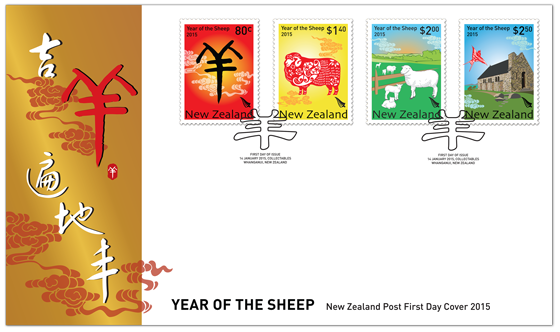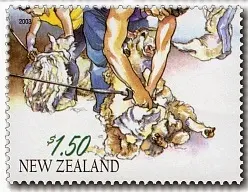 In 2003 and 2015 Chinese celebrated The New Year under the Chinese lunar sign The Year of the Sheep. In both years New Zealand Post issued stamps and a miniature sheet to mark this event. Following on with Allan's series of Chinese New Year issues, I will be looking at both of these issues in this post. When we reach the Year of the Sheep for a third time I hope to include that issue here as well.
In 2003 and 2015 Chinese celebrated The New Year under the Chinese lunar sign The Year of the Sheep. In both years New Zealand Post issued stamps and a miniature sheet to mark this event. Following on with Allan's series of Chinese New Year issues, I will be looking at both of these issues in this post. When we reach the Year of the Sheep for a third time I hope to include that issue here as well.See our complete collection of Chinese New Year Issues.
2015 The Year of the Sheep.
The Chinese Zodiac consists of 12 signs of the zodiac – rat, ox, tiger, rabbit, dragon, snake, horse, sheep, monkey rooster, dog and pig. Also known as Year of the Ram or Goat, the sheep is the eighth animal in the Chinese lunar calendar, and is known to be gentle and calm.
Calm and gentle, I like that; it describes sheep well. Sheep are not dumb animals as many would believe. The main problem is when they are being herded or handled be humans, they become stressed. Then all reason goes out the door. Take your time, herd them gently, keep the dogs backed off and you'll be amazed how much difference it makes.
Calm and gentle, I like that; it describes sheep well. Sheep are not dumb animals as many would believe. The main problem is when they are being herded or handled be humans, they become stressed. Then all reason goes out the door. Take your time, herd them gently, keep the dogs backed off and you'll be amazed how much difference it makes.


80c - Pictogram. $1.40 - Paper-cut Sheep.


$2.00 – Sheep in New Zealand. $2.50 – Church of the Good Shepherd
Notes on the Stamps.
80c - Pictogram.
Many modern day Chinese characters are derived from pictograms – stylised drawings of the object they represent. The pictogram on this stamp is the Chinese character for ‘sheep’, conveying both the appearance and attributes of a sheep.
The lower value of this series, with its pictogram of the yearly animal is one of the features of these Chinese New Year issues. I feel there is a strong need to tie these stamp issues in with Chinese culture, something not done in the earlier issues. I think the pictogram and the paper-cut do this.
$1.40 - Paper-cut Sheep.
In China, paper-cuts are used extensively as home decorations and can be affixed to practically anything, from walls to mirrors and even lanterns to bring good luck. This stamp shows a paper-cut design of a sheep, decorated in traditional Chinese patterns of beauty and tranquillity.
Paper-cuts are often used in Japanese culture too. I remember seeing them, and making them, when I was growing up in Japan. Now in New Zealand we visit the Chinese New Year Festive in Auckland where Paper-cuts are often seen.
$2.00 – Sheep in New Zealand.
Sheep remain an important part of the New Zealand economy, with approximately seven sheep to every person living in New Zealand. This stamp illustrates the tranquil setting of New Zealand’s pastures, perfect for rearing sheep.
On the farm I manage we run 3500 sheep, there are only seven of us working there so that accounts for 49 sheep. It is going to take a lot of city slickers to help meet that ratio mentioned above.
$2.50 – Church of the Good Shepherd.
The Church of the Good Shepherd was the first church built in the South Island’s Mackenzie Basin in 1935 and sits next to the stunning Lake Tekapo. The stamp shows an illustration of the church with a Chinese kite and long white cloud, reflecting the multicultural nature of New Zealand.
This is a change in the larger value. For that last six years a New Zealand icon was featured here. Now we have this church. Sure the church is famous but is it an icon of anywhere? Church of the Good Shepherd; shepherd - sheep, I suppose there is a connection there.
First Day Cover.
Miniature Sheet.
Miniature Sheet First Day Cover.
2003 The Year of the Sheep.
The Chinese believe that good fortune smiles on those born in the Year of the Sheep (also referred to as the Year of the Ram or Goat) because of their pure nature and kind heart. 'Sheep people' are said to be charming, elegant and artistic, and to always have the three most important things in life: food, shelter and clothing.
These are great stamps. They really show some great views of sheep farming. The main problem I have with them is that nothing connects them to Chinese New Year except that two were used on the Chinese New Year miniature sheet.
When I came to do this issue, Allan said to break away from what is said online and use my own experience.
That's a good idea so here goes:-
Herding Sheep.
When moving a mob of sheep, the trick is to watch the leaders. Keep the leaders going right and the rest will mainly follow. Don't worry about stragglers or break-aways. If you have a good team of dogs they'll take care of them. You just watch where those leaders are going. If the leaders suddenly take off while you are micro-managing a few at the back, then you'll be in trouble. Run a dog up either side to head off the herd as required but the rest of the time keep the dogs backed-off. Maybe others do it different but it works for me.
Working the yards.
Sheep get stressed in yards. Yards are not a natural place for them to be. They know being in the yards will most likely mean something 'bad' is going to happen. So handle them only as much as is necessary. Don't get in with them unless you need to. You can usually see just as well leaning on the railings outside. Leaving them to stand for a while helps too. Our main yards by the big wool shed are completely under cover now, we can hold enough sheep for shearing the following day.
Now dogs running over the sheep's backs. Some dogs like to do it. I have one that does. I try to discourage it as the sheep don't like it and it could be dangerous if the dog falls down between them. Could get trampled. Sure it looks great at the farm shows, the audience loves it and the sheep are used to it too.
Sheep Shearing.
There is an art to shearing. Sure I can do it, I'm slow compared to the contract shears we get in. They know how to hold the animal, control the animal to stop it struggling and get the job done. Struggling sheep means someone is going to get hurt, either you or the sheep. A shearer works around the body of the sheep in the same way every time. This method has been proven as the best way to get the fleece off in one piece as quickly as possible.
In the $1.50 stamp you see the sheep is held against the man's legs. This is early in the process where he is doing the legs and the belly. In the second $2.00 stamp, he has the sheep on the floor, holding its head. This is where he makes those long strokes right up the full length of the animal, taking the last of the fleece off in long strips.
The fleece is then taken to the sorting table where dirty wool is removed before its packed in the baler. There is a skill to 'throwing a fleece' so it lands spread out flat on the table. You'll get it on the floor a few times before you get it right.
Miniature Sheet.
The design shows the sheep in the centre with the other 11 signs in a circle around it. That's as a mean looking ram. I wouldn't like to meet him on a dark night. LOL
Head back and up like that, he's a smart one, observing what is going on around him. Get him out in front if you can, he'll be trouble if left at the back.
Technical Information 2015.
Date of issue:- |
14 January, 2015.
|
|---|---|
Number of stamps:-
|
Four gummed stamps.
|
Denominations:-
| 80c, $1.40, $2.00 and $2.50. |
Designed by:-
| Asiaworks, Auckland, New Zealand. |
Printer:-
| Southern Colour Print. |
Process:-
| Offset lithography. |
Number of colours:-
| Four process colours. |
Stamp size and format:-
| 30mm x 40mm (vertical). |
Paper type:-
| Tullis Russell 104gsm red phosphor gummed. |
Stamps per sheet:-
| 25. |
Perforation gauge:-
| 14. |
Period of sale:-
| 14th January, 2015 until 13th January, 2016. |
Technical Information 2003.
Date of Issue:-
| 5 February, 2003. |
|---|---|
Designers:-
| Denise Durkin, Wellington, New Zealand. |
Printer:-
| Southern Colour Print, New Zealand. |
Stamp Size:-
| 40mm x 30mm. |
Sheet Size:-
| 25 Stamps per sheet plus one strip of 5 gutter images. |
Process:
| Lithography. |
Perforation Gauge:
| 14. |
Paper Type:
| De la Rue 103gsm red phosphor coated litho stamp paper. |
Some of the images in this post were used with permission from the illustrated catalogue of StampsNZ
You can visit their web site and On-line Catalogue at, http://stampsnz.com/
Information for this post came from.









Loved the descriptions on herding and shearing sheep.
ReplyDeleteWe don't have sheep here, only dairy.
Nice one Anne.
Kirsten
So Kirsten, are you saying you don't know one end of a sheep from the other?
DeleteAnne.
Now! Now, Anne. Be nice.
DeleteKirsten.
The Year of the Sheep is almost here again. I know it when I see your post in this blog.
ReplyDeleteWell done Anne. It is my understanding you are a new writer here. Keep doing posts like this and you'll be an asset to this blog.
I like the comparison you make with the earlier Year of the Sheep issue. Your insights into sheep farming were a treasure, not that I'm ever likely to herd or shear a sheep.
Hoe
Thank you Hoe
DeleteYes I am a new writer for this blog but I'm not new to blogs, I actually have one of my own.
I am new to collecting stamps. Just learning about that. Get help from Allan and Mary when I need it.
Anne.
We appreciate your engagement with our content. To ensure a respectful and constructive community, please take note of the following:
- No Spam, Please: We do not tolerate spammy or promotional comments. Any such comments will be promptly removed.
- Moderation in Place: All comments are moderated to maintain a positive and inclusive environment. Please be patient, as it may take a little time for your comment to appear.
- Sign In with Google: To comment, please sign in using your Google account. This helps us maintain the integrity of our community and allows for better interaction.